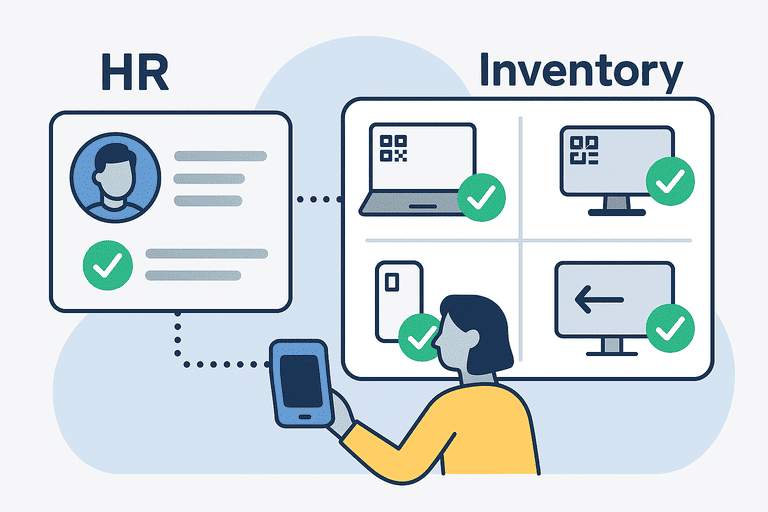Integrating Inventory with HR: Tracking Devices by Employee
Learn how integrating inventory management with HR systems helps businesses track company devices by employee, improve accountability, and streamline offboarding.

Introduction
In many companies, HR manages people, and IT manages devices — but these two systems rarely talk to each other.
This disconnect often leads to lost equipment, incomplete offboarding, or untracked reassignments.
By integrating inventory systems with HR data, organizations gain full visibility into which employees hold which assets — laptops, phones, monitors, or tools — and what happens to them during hiring, role changes, and exits.
This guide explores why HR–inventory integration matters, how it works, and what practices ensure data accuracy and accountability across your organization.
1. The Hidden Cost of Disconnected Systems
Without integration, tracking devices manually through spreadsheets or emails becomes chaotic.
When an employee leaves, IT may not know which devices were assigned — or worse, HR may not realize a laptop or access card is still in circulation.
Common problems include:
- Duplicate assets purchased due to missing records.
- Unreturned devices after offboarding.
- Inconsistent ownership data between HR and IT databases.
- No audit trail of equipment changes or handovers.
The result is not only financial loss but also data security risks, especially with remote and hybrid teams.
2. The Concept of HR–Inventory Integration
Integrating HR and inventory management means syncing employee and asset records through shared identifiers — such as employee ID, department, or email address.
Core integration elements:
- Automatic asset assignment when a new employee is onboarded.
- Real-time updates when employees move between departments.
- Offboarding triggers that flag asset retrieval needs.
- Access control alignment — ensuring only active employees retain device access.
This creates a single source of truth for all company-owned assets tied to each person.
3. Key Benefits of Integration
✅ 1. Full Accountability
Every device is tied to an individual. HR sees who owns what; IT knows where assets are physically located.
✅ 2. Streamlined Onboarding
New hires automatically get assigned standard assets based on their role (e.g., developer = laptop + monitor + keyboard).
✅ 3. Secure Offboarding
When HR processes a departure, the system triggers alerts to collect equipment, revoke credentials, and confirm returns.
✅ 4. Simplified Audits
No more manual reconciliation — asset and employee data stay aligned, allowing automatic verification during audits.
✅ 5. Cost Transparency
Finance teams can easily map asset depreciation and cost allocation to specific departments or users.
4. Implementation Strategy
Step 1: Identify System Roles
- HR system (source of truth): contains employee lifecycle data.
- Inventory platform: tracks assets, condition, and location.
- Integration middleware or API: syncs updates between both.
Step 2: Define Data Mapping
Match employee attributes with asset fields:
| HR Field | Inventory Field | Example |
|---|---|---|
| Employee ID | Assigned User ID | 100245 |
| Department | Cost Center | Marketing |
| Status | Asset Access Flag | Active / Offboarded |
| Hire Date | Assignment Date | 2025-03-11 |
Step 3: Automate Workflows
- Onboarding: Automatically create asset assignment tasks.
- Role change: Notify IT to review current equipment.
- Offboarding: Trigger device return and access deactivation.
Step 4: Audit Regularly
Schedule monthly or quarterly audits to verify employee-asset relationships and check for discrepancies.
5. Data Privacy and Security Considerations
When syncing HR and asset data, privacy compliance is crucial — especially under GDPR or similar regulations.
Best practices:
- Limit shared data to essential fields (avoid personal info beyond work identifiers).
- Use encryption during API communication.
- Control permissions — not every HR admin should see IT data and vice versa.
- Maintain access logs for audit trails.
The goal is transparency without oversharing sensitive information.
6. Tracking Devices Through the Employee Lifecycle
| Stage | HR Event | Inventory Action |
|---|---|---|
| Hiring | New employee created | Assign starter kit assets automatically |
| Promotion / Transfer | Role or department changes | Adjust asset set and update cost center |
| Leave / Termination | Employee status inactive | Trigger retrieval workflow and disable logins |
| Rehire | Employee reinstated | Reassign assets or issue replacements |
This workflow ensures no device is ever “lost” in transition.
7. Common Pitfalls to Avoid
- Relying on manual imports instead of automated syncs.
- Forgetting to define offboarding triggers.
- Failing to reassign recovered devices efficiently.
- Allowing multiple systems (HR, ITSM, inventory) to use inconsistent identifiers.
Integration works only when all systems speak the same language — employee IDs, asset tags, and departments must align.
8. Measuring Success
After integration, measure results through metrics like:
- Percentage of assets assigned to valid employees.
- Number of devices unaccounted for after offboarding.
- Reduction in asset-related helpdesk tickets.
- Audit reconciliation accuracy rate.
These indicators show whether integration is preventing loss and improving transparency.
Conclusion
Integrating HR and inventory data bridges the gap between people and property.
It creates a clear chain of responsibility, smooths onboarding and offboarding, and eliminates guesswork during audits.
By linking assets to employees, businesses not only save money but also strengthen data security and organizational trust.
Explore related articles to enhance asset accountability: